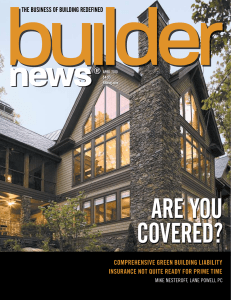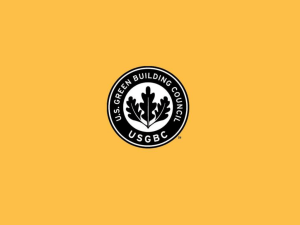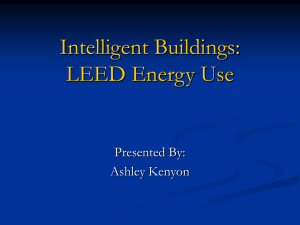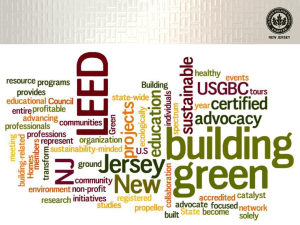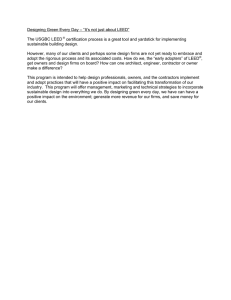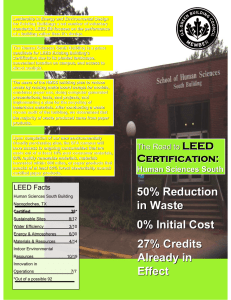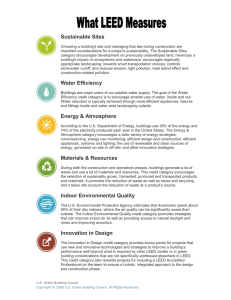a guide for advancing local green building policies
advertisement
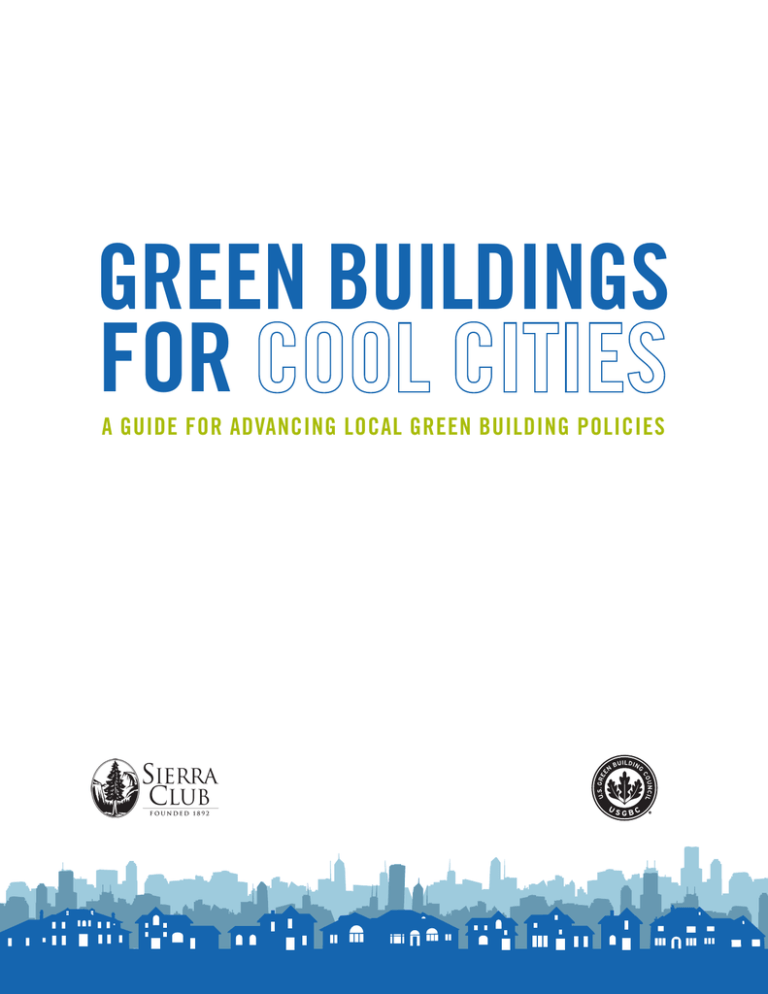
GREEN BUILDINGS FOR A GUIDE FOR ADVANCING LOCAL GREEN BUILDING POLICIES COPYRIGHT Copyright © 2011 by the U.S. Green Building Council®, Inc. The U.S. Green Building Council, Inc., (USGBC®) and the Sierra Club® worked in cooperation and have devoted significant time and resources to create this document, Green Buildings for Cool Cities: A Guide for Advancing Local Green Building Polices (hereinafter referred to as, “The Guide”). The Guide is protected by the copyright and trademark laws of the United States and other countries. Your possession of The Guide constitutes ownership of a material object and in no way constitutes a conveyance of ownership or entitlement to the copyrighted content. You are prohibited from engaging in conduct that would constitute infringement upon the exclusive rights retained by USGBC including the reproduction of, the distribution of, the preparation of derivative works based on, the performance of, and/or the display of the copyrighted works, in whole or in part, except to the extent that such conduct is permitted by law or specifically granted to you by USGBC. LICENSE USGBC hereby grants you a limited, non-exclusive, royalty-free license to reproduce The Guide, in whole or in part, and to distribute such reproductions to third parties. As an express condition to the grant of this license, at all times you shall: i) represent that USGBC and Sierra Club cumulatively are the source, and that USGBC alone is the owner, of this content; ii) retain the copyright, and any other proprietary notices contained herein within all reproductions of this copyrighted material; and iii) restate the terms, conditions, and limitations of this license within all reproductions of this copyrighted material. TRADEMARK USGBC and Sierra Club own several proprietary trademarks, certification marks, and associated acronyms, logos and other graphic images (collectively “Logos”) which are represented herein respectively. Such Logos include but are not limited to the “Sierra Club” trademark, the “LEED®” trademark, the “U.S. Green Building Council” trademark, the “USGBC” trademark, and the “LEED Certified®,” “LEED Silver™,” “LEED Gold™,” and “LEED Platinum™” certification marks. These Logos constitute valuable intellectual property wholly owned and exclusively held by either USGBC or Sierra Club. DISCLAIMER The Guide provides general legal information designed to help readers familiarize themselves with some examples of green building related legislation and other publicly supported programs, as well as a brief discussion of some of the policy issues pertaining thereto. Neither USGBC nor Sierra Club is a law firm or a governmental entity, and neither holds the authority to create or interpret the law. The Guide provides neither legal services nor legal advice. Legal advice requires a thorough review of the law and analysis as to how the law applies in relation to an individual’s or entity’s specific circumstances. Any use of The Guide shall NOT create or constitute a lawyer-client relationship. Further, as the law differs (and changes) in each jurisdiction, and may be interpreted or applied differently depending on the reader’s location or situation, the information or use of the contents of The Guide is not a substitute for the advice of a lawyer. Although both USGBC and Sierra Club have strived to make sure the information contained within The Guide is accurate and useful, USGBC and Sierra Club recommend that readers consult a lawyer. NONE OF THE PARTIES INVOLVED IN THE FUNDING OR CREATION OF THE GUIDE, INCLUDING USGBC, ITS MEMBERS, ITS CONTRACTORS, AND/OR SIERRA CLUB, ASSUME ANY LIABILITY OR RESPONSIBILITY TO THE USER OR ANY THIRD PARTIES FOR THE ACCURACY AND COMPLETENESS OF ANY INFORMATION CONTAINED IN THE GUIDE, OR FOR ANY INJURIES, LOSSES, OR DAMAGES (INCLUDING, WITHOUT LIMITATION, EQUITABLE RELIEF) ARISING FROM THE USE OF THE GUIDE OR RELIANCE ON INFORMATION CONTAINED HEREIN. THE GUIDE AND ITS CONTENTS ARE PROVIDED WITHOUT WARRANTIES OF ANY KIND, EITHER EXPRESS OR IMPLIED, INCLUDING BUT NOT LIMITED TO WARRANTIES OF MERCHANTABILITY, WARRANTIES OF ACCURACY OR COMPLETENESS OF INFORMATION, WARRANTIES OF SUITABILITY OR FITNESS FOR A PARTICULAR PURPOSE, AND/OR WARRANTIES OF TITLE OR NON-INFRINGEMENT, EXCEPT TO THE EXTENT THAT SUCH DISCLAIMERS ARE HELD TO BE INVALID. U.S. Green Building Council, Inc. 2101 L Street Suite 500 Washington, DC 20037 2nd Floor San Francisco, CA 94105 85 Second Street Sierra Club GREEN BUILDINGS FOR COOL CITIES More than 1000 American cities and counties are investing in the future by taking action to reduce their impact on global climate change. Local governments are developing innovative policies and methods to reduce greenhouse gas emissions and demonstrating leadership by pledging commitment to pacts like the U.S. Mayors Climate Protection Agreement and the Cool Counties Climate Stabilization Declaration. The operation, heating and cooling of buildings contribute nearly 40 percent of global warming emissions1 and consume over 70 percent of electricity use in the United States2. As local governments advance climate action plans and determine how to meet their goals, they are discovering that improving the efficiency of their buildings is one of the most effective ways to protect our climate and recharge our economy. That is why the Sierra Club’s Cool Cities Program and the U.S. Green Building Council (USGBC®) have teamed up to advocate for cost-effective, local green building policies. This guide provides our organizations’ joint recommendations for advancing green buildings in your community. In the following pages, you’ll find a step-by-step approach to best practices that address the diverse context and needs of communities big and small, from coast to coast. WHAT MAKES A BUILDING “GREEN”? A green building is one that is designed and constructed to reduce the overall impact of the built environment on human health and the natural environment. Green buildings are designed to efficiently use energy, water, and other natural resources, protect occupant health, improve employee productivity, and reduce pollution. Green buildings often incorporate energy-efficient heating, cooling, lighting, and water systems, including high-performance insulation, windows, doors, and appliances; sustainable construction materials such as those made from recycled and recyclable materials with reduced-emissions; and water-saving site design and landscaping. In addition, green buildings may have, or can be easily suited to, clean renewable power systems. REDUCED ENERGY USE IN GREEN BUILDINGS AS COMPARED WITH CONVENTIONAL BUILDINGS Energy Efficiency (above standard code) Certified Silver Gold Average 18% 30% 37% 28% Source: Capital E Analysis3 THE BENEFITS OF GREEN BUILDINGS Green, high-performance buildings deliver measurable and significant environmental and fiscal benefits. When compared to structures built to conventional construction methods, green buildings: consume 26% less energy4 account for 33% fewer greenhouse gas emissions5 require 13% lower maintenance costs6 yield 27% higher occupant satisfaction7 3 Building green doesn’t have to cost a penny more.8 Investments in green buildings pay dividends and reap rewards, on average resulting in: 6.6% improvement on return on investment9 8–9% reduction in operating costs10 7.5% increase in building value11 3.5% increase in occupancy ratio12 Building green also creates quality jobs. A 2009 USGBC/Booz Allen Hamilton report found that, despite a challenging economic outlook, green building will support nearly 8 million jobs in the U.S. economy and contribute $554 billion to U.S. GDP between 2009 and 2013, many times its contribution to jobs and GDP over the last eight years.13 GREEN BUILDING AND LEED® The most widely accepted green building certification program is LEED, developed by the U.S. Green Building Council, to provide third-party review and verification of the design, construction and operation of green buildings. LEED recognizes excellence for measures that help protect human and environmental health in a variety of areas, including: energy efficiency, sustainable site development, water savings, materials selection and indoor environmental quality. In recent years, thousands of buildings in the United States have achieved LEED certification. Currently, more than 450 localities across the U.S. are recognizing LEED as an effective tool for benchmarking the performance of buildings in their community, and over 3,100 local government projects are currently pursuing LEED certification. Learn more about green building policies: www.usgbc.org/DisplayPage.aspx?CMSPageID=1852 HOW DOES LEED WORK? LEED is a rating system under which projects earn points for satisfying specific green building criteria. The number of points the project earns, as verified by third-party review, determines whether a project will be certified and the level of LEED certification it will achieve. Certification is available in four progressive levels – Certified, Silver, Gold and Platinum. For greater flexibility, LEED allows a variety of point combinations to achieve each certification level, in addition to several minimum prerequisites. Learn more about LEED: www.usgbc.org/LEED Learn more about LEED and energy performance: www.usgbc.org/ShowFile.aspx?DocumentID=8946 COOL CITIES–USGBC GREEN BUILDING POLICY RECOMMENDATIONS The local green building policies described in this guide are organized from basic to more advanced plans of action to address energy efficiency and environmental sustainability across the built environment. Highlighted policies include leadership standards for government buildings that serve as models for the community, financial and no-cost incentives to build green for the commercial and residential sectors, and improved minimum efficiency standards through energy code adoption and enforcement. These rec- 4 ommendations can be used as a foundation for developing new administrative policies, a guide to expanding upon current activities, or combined for a holistic approach. : STEP ONE: Leading by Example and Expanding the Green Building Market I. Green Building Standards for New Municipal Buildings and Major Renovation of Municipal Buildings II. Non-Financial Incentives for Commercial and Residential Buildings III. Green Building Standards and Incentives for Schools and Affordable Housing STEP TWO: RAISING THE BAR – Increasing Standards and Encouraging Private Development I. Green Retrofit Standards for Existing Municipal Buildings II. Higher Standards for New Construction and Major Renovation of Municipal Buildings III. Financial Incentives for Commercial and Residential Buildings STEP THREE: ADVANCED – Greening Our Cities through Energy Rating and Disclosure, Building Codes and Smart Financing 1 I. Rating and Disclosing the Energy Performance of Buildings II. Better Building Codes III. Cost Effective Home Energy Efficiency Financing STEP ONE: LEADING BY EXAMPLE AND EXPANDING THE GREEN BUILDING MARKET The very first step for local governments is to set strong green building standards for new and retrofitted public buildings, including schools, public safety facilities, libraries, and administrative offices. Such buildings are highly visible, demonstrate leadership by example, and help to educate citizens about the benefits and realities of green building. They can also serve as a catalyst for green building communitywide, increasing local expertise and driving down costs. Early actions can also include offering non-financial incentives to advance green building in the private sector and leading the way to make affordable housing green, so that all citizens have access to healthier, more efficient places to live and work. I. GREEN BUILDING STANDARDS FOR NEW MUNICIPAL BUILDINGS AND MAJOR RENOVATION OF MUNICIPAL BUILDINGS Clayton, MO (16,076 pop.) – Requires all new construction and major renovations of city-owned, -occupied, or -funded buildings over 5,000 sq. ft. to earn LEED Silver™ certification. Learn more: www.usgbc.org/ShowFile.aspx?DocumentID=1976 Kearny, NJ (37,295 pop.) – Requires all new municipal buildings to earn a minimum of LEED Silver certification. The Town also offers density bonuses to private redevelopment projects that earn LEED certification. Learn more: www.usgbc.org/ShowFile.aspx?DocumentID=6347 5 Miami–Dade County, FL (2,387,170 pop.) – Requires all new county–owned and county–financed facilities to achieve LEED Silver certification. All major renovations of greater than 50% of replacement cost to achieve LEED Certified®. County-owned, -operated, or -financed renovations of less than 50% of replacement cost but more than $1 million are also required to achieve LEED Certified. Learn more: www.miamidade.gov/govaction/matter.asp?matter=073319&file=true&yearFolder=Y2007 II. NON-FINANCIAL INCENTIVES FOR COMMERCIAL AND RESIDENTIAL BUILDINGS Portsmouth, NH (20,495 pop.) – Provides a density bonus of 4.0 FAR (floor area ratio) for projects that are LEED certifiable as demonstrated by a complete LEED checklist and/or meets appropriate open space requirements. Learn more: www.cityofportsmouth.com/planning/applications.htm Chicago, IL (2,836,658 pop.) – Expedites the permitting process for projects that incorporate innovative green building practices, including LEED certification. Commercial projects striving for LEED certification will receive their permits within 30 days. Projects striving for higher levels of LEED certification are will receive their permits within 30 days and are eligible to receive a partial permit fee waiver of up to $25,000. www.usgbc.org/DisplayPage.aspx?CMSPageID=2078#exp Learn more about Non-Financial Incentives for Commercial and Residential Buildings: http://www.usgbc.org/DisplayPage.aspx?CMSPageID=2078 III. GREEN BUILDING STANDARDS AND INCENTIVES FOR SCHOOLS AND AFFORDABLE HOUSING Cincinnati, OH (332,458 pop.) – Public schools will strive for LEED Silver certification while requiring that at least four schools achieve LEED Silver certification and one additional school achieves LEED Gold™ or LEED Platinum™ certification. Learn more: www.greenschoolbuildings.org/action/connect/k12_initiatives.aspx Anchorage, AK (279,671 pop.) – Requires all new Anchorage School District buildings and major building renovations over 20,000 sq. ft. to achieve LEED Certified. The minimum level of certification will increase to LEED Silver on July 1, 2012. Learn more: www.akcenter.org/files/sustainable-communities/Final%20AO%207-18-08.pdf Washington, DC (581,539 pop.) – The DC Green Building Act of 2006 requires that all publiclyfunded residential projects over 10,000 sq. ft. meet green building standards. While the law only applies directly to projects receiving at least 15% of construction costs from public sources, the DC Department of Housing and Community Development has incorporated Enterprise’s Green Communities Criteria, a national framework for sustainable affordable homes, into all city-funded projects. 6 Learn more: www.dccouncil.washington.dc.us/images/00001/20061218152322.pdf Seattle, WA (582,454 pop.) – The City of Seattle published the SeaGreen Affordable Housing Guide in 2002 to promote energy efficiency, operating savings, and sustainable building methods in affordable multi-family housing developments. City funding for low-income development projects is awarded with consideration of a project’s sustainability plan and adherence to SeaGreen criteria. Learn more: www.seattle.gov/housing/SeaGreen 2 Boston, MA (589,141 pop.) – The City’s Green Affordable Housing Initiative requires that developers of affordable housing projects that receive public funding must adhere to LEED Silver and ENERGY STAR® standards, depending on the size of the project. This initiative is part of Boston’s larger Green Building program. Learn more: www.cityofboston.gov/dnd/D_green_housing.asp STEP TWO: RAISING THE BAR – INCREASING STANDARDS AND ENCOURAGING PRIVATE DEVELOPMENT Local governments can further promote green building community-wide by setting even higher standards for new and retrofitted municipal buildings, and by providing greater incentives for building green residential and commercial buildings. For a full review of green building incentive strategies, see: http://www.usgbc.org/DisplayPage. aspx?CMSPageID=2078. I. GREEN RETROFIT STANDARDS FOR EXISTING MUNICIPAL BUILDINGS Portland, OR (550,396 pop.) – Requires all existing municipal buildings to earn LEED Silver certification. The city also requires all new municipal buildings to earn LEED Gold certification and all municipally-leased facilities to earn LEED Silver certification. Learn more: www.portlandonline.com/shared/cfm/image.cfm?id=112682 II. HIGHER STANDARDS FOR NEW CONSTRUCTION AND MAJOR RENOVATION OF MUNICIPAL BUILDINGS Greensburg, KS (1,383 pop.) – Requires all new city-owned buildings greater than 4,000 sq. ft. to earn LEED Platinum certification, making it the first city in the U.S. to create such a standard. Projects under construction at the time the standard was implemented are also required to register and certify at the LEED Platinum level. Learn more: www.greensburgks.org/news/city-council-passes-resolution-for-greenbuilding/?searchterm=green%20resolution Asheville, NC (73,875 pop.) – Requires that all new, occupied, city-owned buildings greater than or equal to 5,000 sq. ft. achieve a minimum of LEED Gold certification, when project resources and conditions permit. In addition, all new, occupied city-owned buildings less than 5,000 sq. ft. are required to be built to incorporate measures that would allow them to be certified at the LEED Silver level. Learn more: www.dsireusa.org/documents/Incentives/NC16R.pdf III. FINANCIAL INCENTIVES FOR COMMERCIAL AND RESIDENTIAL BUILDINGS Doylestown Borough, PA (8,149 pop.) – Provides a 60% reduction in building permit fees for new commercial and residential construction, additions, and interior remodels earning a minimum of LEED Silver certification through the Green Points Building Incentives Program. Learn more: www.usgbc.org/ShowFile.aspx?DocumentID=6441 7 Chatham County, GA (248,469 pop.) – Provides a full abatement for state and county property taxes for commercial buildings achieving LEED Gold certification for five years, then a decreasing abatement in year six that tapers off by 20% each year until the tenth year. Qualifying projects are new or expanding businesses in an Enterprise Zone that increase employment opportunities. Learn more: www.chathamcounty.org/Chatham/uploads/Agn2006/m2006_05_12.PDF Longmont, CO (82,646 pop.) –Provides new or expanding businesses in Longmont fee and tax rebates up to 30% of each fee if the business exceeds the City’s energy code or pursues LEED certification. Applicable fees include grading permit fees, electrical permit fees, mechanical permit fees, plumbing permit fees, water meter installation fee, city sales tax, and transportation community investment fee. Learn more: library.municode.com/HTML/14590/level3/PTIICOOR_TIT4REFI_CH4.72ECDEIN.html#PTIICOOR_ TIT4REFI_CH4.72ECDEIN_4.72.030APRETAON El Paso, TX (606,913 pop.) – The Green Building Grant Program provides grants for commercial projects greater than 5,000 sq. ft. and/or and multi-family residential projects that obtain LEED certification. Grants are awarded at increasing intervals based on level of certification. Maximum grant allowance is $200,000 for LEED Platinum for new construction and $400,000 for LEED Platinum for multi-family existing buildings that are mixed use and that have been 50% vacant for five years, or as further defined by the City. Learn more: www.ci.el-paso.tx.us/muni_clerk/agenda/09-11-07/09110714A.pdf Middletown, CT (47,481 pop.) – Commercial buildings achieving LEED Gold or Platinum certification are eligible to receive a partial real estate tax exemption equal to a fixed amount of 10% of assessed value spread over two to seven years, depending upon the real estate value of improvements. LEED Silver certified buildings less than $5 million assessed value will also be eligible for a partial real estate tax rebate of 10% spread over two to seven years, depending upon the real estate value of improvements. Learn more: www.ecode360.com/?custId=MI1935&guid=8366130&j=23 Tampa, FL (336,823 pop.) – Offers developers of commercial and multi-family residential buildings a 20–80% rebate on building permit fees, depending on the level of LEED certification that the building earns. The City further offers developers of single-family homes a 50% rebate on building permit fees if the building meets the current Green Home Designation Standards of the Florida Green Building Coalition. Tampa further encourages developers of affordable multi-family and single-family homes to follow the Florida Green Building Coalition’s Green Home Standard. Learn more: docserver.tampagov.net/cache/00001/880/Ordinance%20No.%202008-111%20to%202008118.pdf IV. AMEND THE MULTIPLE LISTING SERVICE TO INCREASE DEMAND FOR GREEN REAL ESTATE The increasing costs and environmental impact of creating energy are driving a social and economic demand for greater efficiency. Properties with efficient and healthy attributes are increasingly desirable if listing agents have the ability to represent environmentally friendly aspects and/or any green certifications that have been awarded to the property to buyers through the MLS. 8 A green MLS benefits everyone, from the home owner investing in better attic insulation to large builders employing new energy efficient construction techniques. Being able to quantify the return on green investments (ROGI) and having a stronger method to market green properties can also motivate more people to become energy and resource efficient. To read more about greening the Multiple Listing Service and for tools and resources, please visit: http://www.greenthemls.org/ Case Studies Atlanta, GA (540,921 pop.) - http://www.greenthemls.org/pdfs/CaseStudy-Atlanta.pdf Chicago, IL (2,859,700 pop.) - http://www.greenthemls.org/pdfs/CaseStudy-Chicago.pdf 3 STEP THREE: ADVANCED – GREENING OUR CITIES THROUGH ENERGY RATING AND DISCLOSURE; BUILDING CODES; AND SMART FINANCING Local governments are empowering consumers to make smart energy choices and developing the market for energy efficiency by embracing energy disclosure and building performance rating policies. These localities are out at the forefront, blazing a trail for others to follow. In addition, innovative local governments are developing creative financing models to help residents and other building owners invest in green building by lowering real or perceived cost barriers to green building and to achieve even greater market penetration. Though sometimes a complicated endeavor, leading local governments are also adopting, implementing and enforcing better building codes to support their sustainability goals. I. DRIVING DEMAND FOR ENERGY EFFICIENCY THROUGH BUILDING ENERGY RATING AND DISCLOSURE The Department of Energy is developing a National Home Energy Score Program. This program’s goal is to develop a credible and consistent method to inform homeowners and home occupants on how to improve their home’s energy performance, and how much energy upgrades will reduce their utility bills. The program is currently in pilot, with an expected launch date of Summer/Fall 2011. Currently, State and local governments are encouraging energy conservation and building upgrades through localized energy disclosure and building energy rating policies. Learn more: http://www.imt.org/rating.html New York, NY (8,363,710 pop.) – Requires large commercial and multifamily buildings to benchmark their energy and water consumption with ENERGY STAR. Benchmarking data will be posted online by the city. The provision is part of the city’s Greener, Greater Buildings Plan, which also requires periodic energy audits and retro-commissioning, lighting upgrades and sub-metering in commercial buildings. Learn more: www.nyc.gov/html/planyc2030/html/plan/buildings_plan.shtml Austin, TX (786,382 pop.) – Austin’s Energy Conservation and Disclosure ordinance requires ENERGY STAR benchmarking for commercial buildings and the disclosure of benchmarking data to prospective buyers. The law also requires energy audits for homes and multifamily buildings, and mandatory energy retrofits in “high energy-use” multi-family buildings. Learn more: http://www.austinenergy.com/About%20Us/Environmental%20Initiatives/ordinance/index.htm 9 Seattle, WA (617,334 pop.) – Seattle expanded on the state-wide rating and disclosure law by requiring annual benchmarking for large commercial and multi-family property owners; disclosure of benchmarking data to the city; and the inclusion of multi-family buildings in the rating and disclosure requirements. Learn more: clerk.ci.seattle.wa.us/~archives/Ordinances/Ord_123226.pdf II. BETTER BUILDING CODES A growing number of state and local governments are analyzing and revising their building codes to better align with their sustainability goals and green building programs. Even where codes are determined at the state level, many local governments are finding that regulatory minimums for the private sector may need upgrades and more comprehensive enforcement strategies to improve public health, safety, and environmental quality. Because building codes are highly-detailed requirements of local and regional priorities, there are no “onesize-fits-all” solutions. However, a landmark national effort to codify green building practices into adoptable, adaptable and enforceable green building codes has produced regulatory documents that are now available as an overlay to more traditional building codes. The International Green Construction Code (IGCC), including ASHRAE Standard 189.1 as an alternate path to compliance, is a widely supported and first-of-its-kind regulatory framework that recognizes an entire set of risks not otherwise addressed in the codes. Built on a similar framework as the IGCC, the State of California was the first to develop and adopt a green building code. Since January 1, 2011, The California Green Building Standards Code is the new baseline for residential and commercial building design and construction. Both distinct and complementary to green building rating systems such as LEED, green building codes are raising the profile of the fundamental importance of codes and standards in smart public policy. These documents are building an important bridge to tomorrow’s codes by establishing high standards for energy and water efficiency, indoor environmental quality, building construction materials, and sensitivity to their impacts. Given the importance of energy efficiency as a cornerstone to building green, every community should demand the protections of a building energy code to safeguard against rising energy costs – especially in an economy that simply cannot afford to waste. The cities of Albuquerque, Boulder, Houston, and Seattle, for example, have all upgraded their codes by meeting or exceeding some of the most recent versions of the model energy codes for residential and/or commercial buildings. Additionally, more than 50 jurisdictions in the Commonwealth of Massachusetts have adopted the Massachusetts Stretch Energy Code. The most widely-accepted code for minimum residential and commercial14 energy performance is the most recent version of the International Energy Conservation Code (IECC).15 The 2009 IECC is reported to increase energy efficiency by 12–15% over the previous code from 2006 , and the 2012 version, amended in October, 2010, will provide an additional 15% efficiency improvement. Equally important as energy code upgrades is a focus on energy code enforcement, which, according to a recent study, was a lower priority for code officials, resulting in lower likelihood of compliance.16 Learn more: USGBC Policy Brief: LEED and Green Building Codes (http://www.usgbc.org/ShowFile. aspx?DocumentID=9246) U.S. Department of Energy’s Building Energy Codes Program (www.energycodes.gov) 10 The Building Codes Assistance Project (bcap-ocean.org/policy-action-tool) The International Green Construction Code (www.iccsafe.org/cs/IGCC) ASHRAE Standard 189.1 (www.ashrae.org/greenstandard) California Green Building Standards Code (http://www.documents.dgs.ca.gov/bsc/CALGreen/2010_CA_Green_ Bldg.pdf ) USGBC’s white paper on Greening the Codes (www.usgbc.org/governmenthttp://www.usgbc.org/ShowFile. aspx?DocumentID=7403) III. COST EFFECTIVE HOME ENERGY EFFICIENCY FINANCING In many cases, energy efficiency savings can provide a cost-neutral or reduced-cost option for improving the efficiency of a home or building. A number of local jurisdictions are finding creative ways to enable, and motivate, consumers to make investments in energy efficiency and tap into the cost effective potential. Programs can be managed and financed through a number of sources including local utility providers, city agencies, or special tax assessment districts. In the summer of 2010, the structure of these types of loans was challenged by Fannie Mae and Freddie Mac over concerns about seniority of the loans. While many of these programs have been placed on hold pending resolution of this concern, Property Assessed Clean Energy (PACE) financing has proven to be a highly-effective mechanism for delivering building energy efficiency in many U.S. communities. To read more about the potential models being deployed in cities around the country, please visit: www.pacenow.org and www.newenergycities.org Learn more about PACE for Commercial Buildings: http://eetd.lbl.gov/ea/ems/reports/pace-pb-032311.pdf Babylon, NY (216,125 pop.) – The Town of Babylon, under the Long Island Green Homes (LIGH) initiative, offers residents low-interest loans for retrofitting their homes at no out-of-pocket cost to the homeowner. Through a $2 million revolving loan fund, the Town subsidizes up to $12,000 of upgrades per home, obliging the homeowner to pay a monthly benefit assessment fee which is, generally, lower than the monthly energy savings realized from the improvements. Should the monthly obligation be in arrears, it is assigned to the property tax. The Town levies a 3% administrative fee incorporated into the monthly payments. Should the homeowner move before the obligation is satisfied, the obligation stays with the home. Learn more: ligreenhomes.com and www.TheBabylonProject.org Racine, WI (82,196 pop.) – Offers upfront financing for energy and water saving improvements for owner-occupied homes. Homeowners pay for the improvements through small payments over time, paying less than is saved as a result of the upgrades. The program is open to residents who own homes built between 1946 and 1975, to maximize energy savings potential. Learn more: www.retrofitracine.org/base/ Sonoma County, CA (466,741 pop.) – The Sonoma County Energy Independence Program gives commercial and residential property owners the opportunity to borrow funds to increase their property’s energy efficiency. Qualifying retrofits include insulation, cool roofing, heating and air conditioning systems, waterless urinals, solar panels and energy efficient windows. The money is paid back as an assessment on the property, due at the same time as the property taxes. Five, ten, and twenty year terms are available at 7% interest. Learn more: www.sonomacountyenergy.org/energy-improvements.php 11 Tallahassee, FL (360,013 pop.) – As part of the municipal utilities demand side management plan, the City of Tallahassee Utilities offers loans to customers for energy efficiency measures. Customers may borrow up to $10,000 at a 5% interest rate. Improvements include energy efficient electric heat pumps, central air conditioning and natural gas heating, tank or tankless water heaters, natural gas range/oven and fire logs, ceiling insulation, refrigerators, and solar water heating systems. Learn more: http://www.talgov.com/you/energy/loans.cfm TAKING ACTION As the model practices in this document demonstrate, cities and counties across the U.S. are moving forward with practical and innovative green building solutions. These actions are creating new green jobs, expanding markets for clean energy technology, and lowering energy demand and resulting emissions. However, to fulfill its promise to become a major clean energy solution, the green building movement has to be scaled up dramatically and rapidly. That’s where you come in. Green building policies are local issues, and we need your help to organize in your community with fellow concerned citizens and activists. The Sierra Club’s Cool Cities Program and USGBC are asking their members to launch joint, local green building campaigns to promote the many benefits of building green, and to encourage local communities and public officials to take action. Please contact your local Sierra Club (cool.cities@sierraclub.org) and USGBC chapters (publicpolicy@usgbc.org) today to get started. Whether your community will be taking its first step or is looking to strengthen its commitments to green buildings, you can help lead your community towards a healthier, more productive and greener future. ABOUT THE SIERRA CLUB AND THE U.S. GREEN BUILDING COUNCIL The Sierra Club is America’s oldest, largest, and most influential grassroots environmental organization, with more than 1.3 million friends and supporters. The club’s Cool Cities Program supports hundreds of local communities in their efforts to reduce global warming with a wide range of practical and cost-effective solutions. To learn more at about how you can make your community cool, see www.coolcities.us. The U.S. Green Building Council is committed to a prosperous and sustainable future for our nation through cost-efficient and energy-saving green buildings. With a community comprising 80 local affiliates, more than 19,000 member companies and organizations, and more than 134,000 LEED credentialed professionals, USGBC leads a diverse constituency of builders and environmentalists, corporations and nonprofit organizations, elected officials and concerned citizens, and teachers and students. To learn more about greening the buildings in your community, see www.usgbc.org. 12 REFERENCES Energy Information Administration. “Assumptions to the Annual Energy Outlook” (2008). http://www.eia.gov/oiaf/archive/ aeo08/index.html 1 Environmental Information Administration. “EIA Annual Energy Review” (2008). http://www.eia.doe.gov/emeu/aer/pdf/aer.pdf 2 Kats, G. “The Costs of Financial Benefits of Green Building: A Report to California’s Sustainable Building Task Force” (2003). http://www.usgbc.org/docs/news/news477.pdf 3 GSA Public Buildings Service. “Assessing green building performance: A post occupancy evaluation of 12 GSA buildings” (2008). http://www.gsa.gov/graphics/pbs/GSA_Assessing_Green_Full_Report.pdf 4 GSA Public Buildings Service, Ibid. 5 GSA Public Buildings Service, Ibid. 6 GSA Public Buildings Service, Ibid. 7 Davis Langdon. “The Cost of Green Revisited: Reexamining the Feasibility and Cost Impact of Sustainable Design in the Light of Increased Market Adoption” (2007). http://www.davislangdon.com/upload/images/publications/USA/The%20Cost%20of%20 Green%20Revisited.pdf 8 McGraw-Hill Construction. “Green Building SmartMarket Report” (2006). http://construction.ecnext.com/coms2/summary_0249-87264_ITM_analytics 9 McGraw-Hill Construction, Ibid. 10 McGraw-Hill Construction, Ibid. 11 McGraw-Hill Construction, Ibid. 12 U.S. Green Building Council and Booz Allen Hamilton. “Green Jobs Study” (2009). http://www.usgbc.org/ShowFile. aspx?DocumentID=6435 13 The most widely-accepted standard for minimum commercial building energy performance is the most current version of ASHRAE Standard 90.1. The 2007 version is reported to be 20% more efficient than its previous version from 2004. This standard is referenced in Chapter 5 of the 2009 IECC. ANSI/ASHRAE/IESNA Standard 90.1-2007 – Energy Standard for Buildings Except Low-Rise Residential Buildings, and is a product of the American Society of Heating, Refrigeration and Air-Conditioning Engineers, a standards-writing organization. www.ashrae.org 14 2009 International Energy Conservation Code, a product of the International Code Council, a code developing organization. www.iccsafe.org 15 Building Codes Assistance Project and North American Insulation Manufacturers Association. “Residential Building Energy Codes – Enforcement & Compliance Study” (2008). http://bcap-energy.org/files/Residential_Survey_Report_Oct08.pdf 16 13 sierraclub.org USGBC.org


